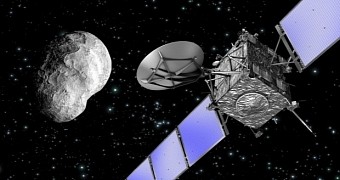Last year, on August 6, the European Space Agency's Rosetta spacecraft officially became the first probe ever to reach a comet and successfully place itself in its orbit.
Having spent several months circling Comet 67P/Churyumov-Gerasimenko, otherwise known simply as 67P/C-G, the probe is now getting ready to complete a historic flyby of its target.
Thus, come February 14, the Rosetta spacecraft will buzz by its target comet at a distance of just 6 kilometers (3.7 miles) from its surface. Check out the animation below to see how the fly will play out.
Why make the spacecraft come this close to the comet?
On November 12, 2014, folks with the European Space Agency successfully landed a probe on the surface of Comet 67P/Churyumov-Gerasimenko. The lander, dubbed Philae, is still lurking on the space rock.
Hence, some might be wondering why the scientists behind this mission don't just use Philae to study the comet's surface. Well, the thing is that, first off, they aren't exactly sure where the lander is hidden on the surface of 67P/Churyumov-Gerasimenko.
Besides, the Philae lander is now in hibernation mode and will only wake up sometime in May or June, provided that, by then, it gets enough sunlight to recharge its batteries. Simply put, the lander is in no condition to do any exploration work.
Add to this the fact that, since it will be flying by it, Rosetta will surely get to image a wider region of its target comet's surface than Philae ever could, and the mission that researchers have planned for February 14 makes perfect sense.
What Rosetta's close encounter with the comet will entail
Comet 67P/Churyumov-Gerasimenko comprises two lobes. On February 14, Rosetta will pass over the larger one. During this flight, the probe will map the comet's surface and collect data concerning the chemical makeup of the innermost parts of the atmosphere that surrounds this space rock.
“The upcoming close flyby will allow unique scientific observations, providing us with high-resolution measurements of the surface over a range of wavelengths and giving us the opportunity to sample – taste or sniff – the very innermost parts of the comet’s atmosphere,” explains scientist Matt Taylor.
It is understood that, in the months to come, the Rosetta spacecraft will perform several other flybys at distances ranging between 15 kilometers and 100 kilometers (9.3 miles and 62 miles). The end goal is to study the comet and its growing coma in unprecedented detail.

 14 DAY TRIAL //
14 DAY TRIAL //